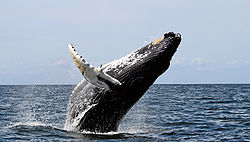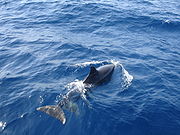Cetacea
| Cetaceans[1] Fossil range: 55–0 Ma Early Eocene - Present |
|
|---|---|
 |
|
| Humpback Whale breaching | |
| Scientific classification | |
| Kingdom: | Animalia |
| Phylum: | Chordata |
| Class: | Mammalia |
| Infraclass: | Eutheria |
| Superorder: | Laurasiatheria |
| (unranked) | Cetartiodactyla |
| (unranked) | Cetancodonta |
| Order: | Cetacea Brisson, 1762 |
| Suborders | |
|
Mysticeti |
|
| Diversity | |
| Around 88 species; see list of cetaceans or below. | |
The order Cetacea (pronounced /sɨˈteɪʃ(i)ə/, L. cetus, whale, from Greek) includes the marine mammals commonly known as whales, dolphins, and porpoises. Cetus is Latin and is used in biological names to mean "whale"; its original meaning, "large sea animal", was more general. It comes from Ancient Greek κῆτος (kētos), meaning "whale" or "any huge fish or sea monster". In Greek mythology the monster Perseus defeated was called Ceto, which is depicted by the constellation of Cetus. Cetology is the branch of marine science associated with the study of cetaceans.
Cetaceans are the mammals best adapted to aquatic life. Their body is fusiform (spindle-shaped). The forelimbs are modified into flippers. The tiny hindlimbs are vestigial; they do not attach to the backbone and are hidden within the body. The tail has horizontal flukes. Cetaceans are nearly hairless, and are insulated from the cooler water they inhabit by a thick layer of blubber. Some species are noted for their high intelligence.
Contents |
Respiration

Cetaceans breathe air. They surface periodically to exhale carbon dioxide and inhale a fresh supply of oxygen. During diving, a muscular action closes the blowholes (nostrils), which remain closed until the cetacean next breaks the surface; when it surfaces, the muscles open the blowholes and warm air is exhaled.
Cetaceans' blowholes have evolved to a position at the top of the head, simplifying breathing in sometimes rough seas. When the stale air, warmed from the lungs, is exhaled, it condenses as it meets colder external air. As with a terrestrial mammal breathing out on a cold day, a small cloud of 'steam' appears. This is called the 'blow' or 'spout' and varies by species in terms of shape, angle and height. Species can be identified at a distance using this characteristic.
Cetaceans can remain under water for much longer periods than other mammals, (approximately 7–30 minutes, varying by species) due to large physiological differences. Two studied advantages of cetacean physiology let this Order (and other marine mammals) forage underwater for extended periods without breathing:
- Mammalian myoglobin concentrations in skeletal muscle have much variation. New Zealand white rabbits have 0.08 grams (0.0028 oz) +/- 0.6 grams (0.021 oz) myoglobin in 100 grams (3.5 oz) wet muscle,[2] whereas a Northern Bottlenose Whale has 6.34 grams (0.224 oz).[3] Myoglobin, by nature, has a higher oxygen affinity than hemoglobin. The higher the myoglobin concentration in skeletal muscle, the longer the animal can stay underwater.
- Increased body size also increases maximum dive duration. Greater body size implies increased muscle mass and increased oxygen stores. Cetaceans also obey Kleiber's law, which states that mass and metabolic rate are inversely related. I.e., larger animals consume less oxygen than smaller animals per unit mass.
Vision, hearing and echolocation
Cetacean eyes are set on the side rather than the front of the head. This means that only cetaceans with pointed 'beaks' (such as dolphins) have good binocular vision forward and downward. Tear glands secrete greasy tears, which protect the eyes from the salt in the water. The lens is almost spherical, which is most efficient at focusing the minimal light that reaches deep water. Cetaceans make up for their generally poor vision (with the exception of the dolphin) with excellent hearing.
As with the eyes, cetacean ears are also small. Life in the sea accounts for the cetacean's loss of its external ears, whose function is to collect and focus airborne sound waves. However, water conducts sound better than air, so the external ear is unneeded: it is a tiny hole in the skin, just behind the eye. The highly developed inner ear can detect sounds from dozens of miles away and discern from which direction the sound comes.
Odontoceti are generally capable of echolocation.[4] From this, Odontoceti can discern the size, shape, surface characteristics and movement of the object, as well as how far away it is. With this ability cetaceans can search for, chase and catch fast-swimming prey in total darkness. Echolocation is so advanced in most Odontoceti that they can distinguish between prey and non-prey (such as humans or boats); captive Odontoceti can be trained to distinguish between, for example, balls of different sizes or shapes. Mysticeti have little need of echolocation, because they prey upon tiny fish such as krill that are impractical to locate with echolocation.
Cetaceans also use sound to communicate, whether it be groans, moans, whistles, clicks or the complex 'singing' of the Humpback Whale.
Feeding
The toothed whales such as the Sperm Whale, Beluga, dolphins and porpoises, have teeth that they use for catching fish, squid or other marine life. They do not chew but swallow prey whole. When they catch large prey, such as when the Orca (Orcinus orca) catches a seal, they bite off and swallow one chunk at a time.
Mysticeti instead have baleen plates made of keratin (the same substance as human fingernails) which hang from the upper jaw. These plates filter small animals (such as krill and fish) from the seawater. Cetaceans included in this group include the Blue, Humpback, Bowhead and Minke whales.
Not all Mysticeti feed on plankton: the larger species eat small shoaling fish, such as herring and sardine, called micronecton. The Gray Whale (Eschrichtius robustus), is a benthic feeder, primarily eating sea floor crustaceans.
Mammalian nature
Cetaceans are mammals, that is, members of the class Mammalia. The closest living relatives of cetaceans are the even-toed ungulates, such as the hippopotamus and deer.[5][6]
Mammalian characteristics include warm-bloodedness, breathing air through their lungs, and suckling their young, and growing hair, although very little of it.
Another way of distinguishing a cetacean from a fish is by the shape of the tail. Fish tails are vertical and move from side to side when the fish swims. Cetacea tails—called a fluke—are horizontal and move up and down, because cetacea spines bend in the same manner as a human spine.
Taxonomy

The order Cetacea contains about ninety species, all marine except for four species of freshwater dolphins. The order contains two suborders, Mysticeti (baleen whales) and Odontoceti (toothed whales, which includes dolphins and porpoises). The species range in size from Commerson's Dolphin, smaller than a human, to the Blue Whale, the largest mammal known to have lived.
Mysticeti vs Odontoceti
Fossils indicate that before evolving baleen, Mysticeti also had teeth, so defining the Odontoceti via teeth alone is problematic, and paleontologists have instead identified other features uniting fossil and modern odontocetes that are not shared by Mysticetes.
| Characteristic | Odontoceti | Mysticeti |
| Feeding | Echolocation, fast | Filter feeder, not fast |
| Size | Smaller (except Sperm whale) | Larger |
| Blowhole | One | Two |
| Dentition | Teeth | Baleen plates |
| Melon | Ovoid, in anterior facial region | Vestigial or none |
| Skull and facial tissue | Dorsally asymmetric | Symmetric |
| Sexual dimorphism | Some species have larger males | Females always larger |
| Mandible | Symphyseal | Nonsymphyseal |
| Pan bone of lower jaw | Yes | No |
| Maxillae projection | Outward over expanded supraorbital processes | Under eye orbit, with bony protuberance anterior to eye orbit |
| Tympanic bulla and periotic bone | Fused, equal sized | Larger, separate tympanic |
Tree
The classification here closely follows Dale W. Rice, Marine Mammals of the World: Systematics and Distribution (1998), which has become the standard taxonomy reference in the field. There is very close agreement between this classification and that of Mammal Species of the World: 3rd Edition (Wilson and Reeder eds., 2005). Any differences are noted using the abbreviations "Rice"[8] and "MSW3"[1] respectively. Further differences due to recent discoveries are also noted.
Discussion of synonyms and subspecies are relegated to the relevant genus and species articles.
- ORDER CETACEA
- Suborder Mysticeti: Baleen whales
- Family Balaenidae: Right whales and Bowhead Whale
- Genus Balaena
- Bowhead Whale, Balaena mysticetus
- Genus Eubalaena
- North Atlantic Right Whale, Eubalaena glacialis
- North Pacific Right Whale, Eubalaena japonica
- Southern Right Whale, Eubalaena australis
- Genus Balaena
- Family Balaenopteridae: Rorquals
- Subfamily Balaenopterinae
- Genus Balaenoptera
- Common Minke Whale, Balaenoptera acutorostrata
- Antarctic Minke Whale, Balaenoptera bonaerensis
- Sei Whale, Balaenoptera borealis
- Bryde's Whale, Balaenoptera brydei
- Eden's Whale Balaenoptera edeni - Rice lists this as a separate species, MSW3 does not
- Balaenoptera omurai - MSW3 lists this is a synonym of Bryde's Whale but suggests this may be temporary.
- Blue Whale, Balaenoptera musculus
- Fin Whale, Balaenoptera physalus
- Genus Balaenoptera
- Subfamily Megapterinae
- Genus Megaptera
- Humpback Whale, Megaptera novaeangliae
- Genus Megaptera
- Subfamily Balaenopterinae
- Family Eschrichtiidae
- Genus Eschrichtius
- Gray Whale, Eschrichtius robustus
- Genus Eschrichtius
- Family Neobalaenidae: Pygmy Right Whale
- Genus Caperea
- Pygmy Right Whale, Caperea marginata
- Genus Caperea
- Family Balaenidae: Right whales and Bowhead Whale
- Suborder Odontoceti: toothed whales
- Family Delphinidae: Dolphin
- Genus Cephalorhynchus
- Commerson's Dolphin, Cephalorhyncus commersonii
- Chilean Dolphin, Cephalorhyncus eutropia
- Heaviside's Dolphin, Cephalorhyncus heavisidii
- Hector's Dolphin, Cephalorhyncus hectori
- Genus Delphinus
- Long-beaked Common Dolphin, Delphinus capensis
- Short-beaked Common Dolphin, Delphinus delphis
- Arabian Common Dolphin, Delphinus tropicalis. Rice recognises this as a separate species. MSW3 does not.
- Genus Feresa
- Pygmy Killer Whale, Feresa attenuata
- Genus Globicephala
- Short-finned Pilot Whale, Globicephala macrorhyncus
- Long-finned Pilot Whale, Globicephala melas
- Genus Grampus
- Risso's Dolphin, Grampus griseus
- Genus Lagenodelphis
- Fraser's Dolphin, Lagenodelphis hosei
- Genus Lagenorhynchus
- Atlantic White-sided Dolphin, Lagenorhynchus acutus
- White-beaked Dolphin, Lagenorhynchus albirostris
- Peale's Dolphin, Lagenorhynchus australis
- Hourglass Dolphin, Lagenorhynchus cruciger
- Pacific White-sided Dolphin, Lagenorhynchus obliquidens
- Dusky Dolphin, Lagenorhynchus obscurus
- Genus Lissodelphis
- Northern Right Whale Dolphin, Lissodelphis borealis
- Southern Right Whale Dolphin, Lissodelphis peronii
- Genus Orcaella
- Irrawaddy Dolphin, Orcaella brevirostris
- Australian Snubfin Dolphin, Orcaella heinsohni. 2005 discovery, thus not recognized by Rice or MSW3 and subject to revision.
- Irrawaddy Dolphin, Orcaella brevirostris
- Genus Orcinus
- Killer Whale, Orcinus orca
- Genus Peponocephala
- Melon-headed Whale, Peponocephala electra
- Genus Pseudorca
- False Killer Whale, Pseudorca crassidens
- Genus Sotalia
- Tucuxi, Sotalia fluviatilis, see the species article for a discussion
- Costero, Sotalia guianensis, see the species article for a discussion
- Genus Sousa
- Pacific Humpback Dolphin, Sousa chinensis
- Indian Humpback Dolphin, Sousa plumbea
- Atlantic Humpback Dolphin, Sousa teuszii
- Genus Stenella
- Pantropical Spotted Dolphin, Stenella attenuata
- Clymene Dolphin, Stenella clymene
- Striped Dolphin, Stenella coeruleoalba
- Atlantic Spotted Dolphin, Stenella frontalis
- Spinner Dolphin, Stenella longirostris
- Genus Steno
- Rough-toothed Dolphin, Steno bredanensis
- Genus Tursiops - Rice and MSW3 tentatively agree on this classification but see species article for more detail.
- Indian Ocean Bottlenose Dolphin, Tursiops aduncus
- Common Bottlenose Dolphin, Tursiops truncatus
- Genus Cephalorhynchus
- Family Monodontidae
- Genus Delphinapterus
- Beluga, Delphinapterus leucas
- Genus Monodon
- Narwhal, Monodon monoceros
- Genus Delphinapterus
- Family Phocoenidae: Porpoises
- Genus Neophocaena
- Finless Porpoise, Neophocaena phocaenoides
- Genus Phocoena
- Spectacled Porpoise, Phocoena dioptrica
- Harbour Porpoise, Phocoena phocaena
- Vaquita, Phocoena sinus
- Burmeister's Porpoise, Phocoena spinipinnis
- Genus Phocoenoides
- Dall's Porpoise, Phocoenoides dalli
- Genus Neophocaena
- Family Physeteridae: Sperm Whale family
- Genus Physeter
- Sperm Whale, Physeter catodon (syn. P. macrocephalus)
- Genus Physeter
- Family Kogiidae - MSW3 treats Kogia as a member of Physeteridae
- Genus Kogia
- Pygmy Sperm Whale, Kogia breviceps
- Dwarf Sperm Whale, Kogia sima
- Genus Kogia
- Superfamily Platanistoidea: River dolphins
- Family Iniidae
- Genus Inia
- Amazon River Dolphin, Inia geoffrensis
- Bolivian River Dolphin, Inia boliviensis
- Amazon River Dolphin, Inia geoffrensis
- Genus Inia
- † Family Lipotidae - MSW3 treats Lipotes as a member of Iniidae
- Family Pontoporiidae - MSW3 treats Pontoporia as a member of Iniidae
- Genus Pontoporia
- La Plata Dolphin, Pontoporia blainvillei
- Genus Pontoporia
- Family Platanistidae
- Genus Platanista
- Ganges and Indus River Dolphin, Platanista gangetica. MSW3 treats Platanista minor as a separate species, with common names Ganges River Dolphin and Indus River Dolphin, respectively.
- Genus Platanista
- Family Iniidae
- Family Ziphidae, Beaked whales
- Genus Berardius
- Arnoux's Beaked Whale, Berardius arnuxii
- Baird's Beaked Whale (North Pacific Bottlenose Whale), Berardius bairdii
- Subfamily Hyperoodontidae
- Genus Hyperoodon
- Northern Bottlenose Whale, Hyperoodon ampullatus
- Southern Bottlenose Whale, Hyperoodon planifrons
- Genus Indopacetus
- Indo-Pacific Beaked Whale (Longman's Beaked Whale), Indopacetus pacificus
- Genus Mesoplodon, Mesoplodont Whale
- Sowerby's Beaked Whale, Mesoplodon bidens
- Andrews' Beaked Whale, Mesoplodon bowdoini
- Hubbs' Beaked Whale, Mesoplodon carlhubbsi
- Blainville's Beaked Whale, Mesoplodon densirostris
- Gervais' Beaked Whale, Mesoplodon europaeus
- Ginkgo-toothed Beaked Whale, Mesoplodon ginkgodens
- Gray's Beaked Whale, Mesoplodon grayi
- Hector's Beaked Whale, Mesoplodon hectori
- Layard's Beaked Whale, Mesoplodon layardii
- True's Beaked Whale, Mesoplodon mirus
- Perrin's Beaked Whale, Mesoplodon perrini. This species was recognised in 2002 and as such is listed by MSW3 but not Rice.
- Pygmy Beaked Whale, Mesoplodon peruvianus
- Stejneger's Beaked Whale, Mesoplodon stejnegeri
- Spade Toothed Whale, Mesoplodon traversii
- Genus Hyperoodon
- Genus Tasmacetus
- Tasman Beaked Whale (Shepherd's Beaked Whale), Tasmacetus shepherdi
- Genus Ziphius
- Cuvier's Beaked Whale, Ziphius cavirostris
- Genus Berardius
- Family Delphinidae: Dolphin
- Suborder Mysticeti: Baleen whales
†Extinct
See also
- American Cetacean Society
- Baleen whale
- Beached whale
- Cetacean bycatch
- Cetacean Conservation Center
- Cetacean intelligence
- Evolution of cetaceans
- Famous cetaceans
- List of cetaceans
- List of dolphin species
- List of extinct cetaceans
- List of porpoise species
- List of whale species
- Toothed whale
- Vocal learning
- Whale
- Whale fall
- Whale surfacing behavior
- Whale watching
- Whaling
References
- ↑ 1.0 1.1 Mead, James G.; Brownell, Robert L., Jr. (16 November 2005). "Order Cetacea (pp. 723-743)". In Wilson, Don E., and Reeder, DeeAnn M., eds. Mammal Species of the World: A Taxonomic and Geographic Reference (3rd ed.). Baltimore: Johns Hopkins University Press, 2 vols. (2142 pp.). ISBN 978-0-8018-8221-0. OCLC 62265494. http://www.bucknell.edu/msw3/browse.asp?id=14300001.
- ↑ Castellini and Somero, 1981
- ↑ Scholander, 1940
- ↑ Hooker, Sascha K. (2009). Perrin, William F.; Wursig, Bernd; Thewissen, J. G. M.. eds. Encyclopedia of Marine Mammals (2 ed.). 30 Corporate Drive, Burlington Ma. 01803: Academic Press. p. 1176. ISBN 978-0-12-3733553-9. http://www.elsevier.com/wps/find/bookdescription.cws_home/716899/description#description.
- ↑ University Of Michigan (2001, September 20). "New Fossils Suggest Whales And Hippos Are Close Kin". ScienceDaily. http://www.sciencedaily.com/releases/2001/09/010920072245.htm. Retrieved 2007-12-21.
- ↑ Northeastern Ohio Universities Colleges of Medicine and Pharmacy (2007, December 21). "Whales Descended From Tiny Deer-like Ancestors". ScienceDaily. http://www.sciencedaily.com/releases/2007/12/071220220241.htm. Retrieved 2007-12-21.
- ↑ Hooker, Sascha K. (2009). Perrin, William F.; Wursig, Bernd; Thewissen, J. G. M.. eds. Encyclopedia of Marine Mammals (2 ed.). 30 Corporate Drive, Burlington Ma. 01803: Academic Press. p. 1174. ISBN 978-0-12-3733553-9. http://www.elsevier.com/wps/find/bookdescription.cws_home/716899/description#description.
- ↑ Rice, Dale W. (1998). "Marine mammals of the world: systematics and distribution". Society of Marine Mammalogy Special Publication Number 4: 231pp.
External links
- "Cetacean Research & Rescue Unit". UK: Cetacean Research & Rescue Unit. http://www.crru.org.uk/. Retrieved March 2010. Including a page on taxonomy
- "Dolphin and Whale News". Science Daily. http://www.sciencedaily.com/news/plants_animals/dolphins_and_whales/. Retrieved March 2010.
- Futuyma, Douglas J. (1998). "Cetacea Evolution". http://www.stephenjaygould.org/library/futuyma_cetacea.html. Retrieved 2010.
- "Whale Trackers". http://www.whaletrackers.com. Retrieved March 2010. A documentary series about whales, dolphins and porpoises
|
||||||||||||||
|
||||||||||||||||||||||||||||||||||||||||||||||||||||||||||||||||||||||||||||||||||||||||||||||||||||||||||||||||||||||||||||||||||||||||||||||||||||||||||||||||||||||||||||||